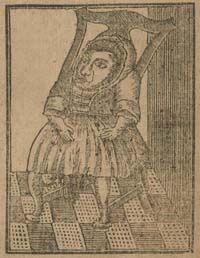Emma Leach
The first human curiosity to be exhibited in the United State was the dwarf Emma Leach, an “extraordinary person who … made her appearance” in Boston in 1771. Leach’s portrait appears in Ames’s Almanack (Boston, 1771), whose large readership referred to its pages for practical information and entertainment pieces alike. The portrait of Leach appears alongside two other portraits, those of the Pennsylvania politician John Dickinson and the English historian Catharine Macaulay. Of the three portraits, only Leach’s is accompanied by an article. The article focuses on her size and health, providing the reader with little insight into her life. Leach was singled out for her “extraordinary” physical features.
Although the article reports that Leach was twenty-two inches tall from head to toe, the author cautions that the article “may not be so particular as the curious would desire, as she would not admit of an accurate examination.” This is noteworthy, particularly given that the piece in fact does discuss much of Leach’s body in great detail. The only part of her body not afforded space in the article is her genitalia. Leach’s refusal to “admit to an accurate examination” was an act of defiance made by a woman whose control over her own body was likely very limited.
